The Town Where George Washington Went to Relax is Pretty Cute
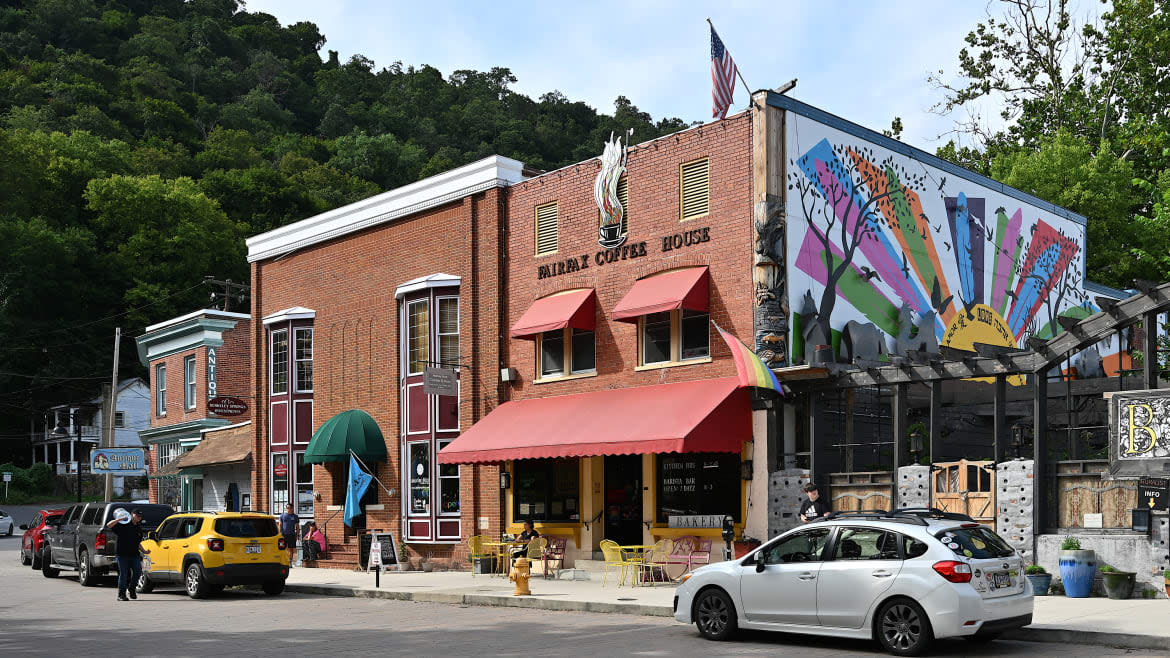
When driving long distances, I always prefer to take the scenic route. I set Google Maps to avoid highways and venture forth, reveling in the slow-paced, single-lane bliss of America’s rural pockets. I pass fading Main Streets, their heydays long past, admiring the storefronts, churches, and courthouses which were built with such obvious pride a century ago. It’s this homespun landscape which the Interstate system forces us to bypass, ignoring the towns, fields, and thoroughfares that link our present to a humbler past. Of course I could reach my destination sooner by highway, but I will have gleaned nothing meaningful from the exercise. By taking the lesser route, I feel a kinship with yesteryear’s generations of townsfolk, migrants, and roadtrippers. Traveling this way, driving feels like an event in and of itself rather than a tedious mastication, no mile more memorable than any other.
Just before Thanksgiving, I happily took such a scenic route wherein my destination was the picturesque spa town of Berkeley Springs, West Virginia. I rode Amtrak’s Acela from New York to Baltimore, a trip of just over two hours, where I picked up a rental car to continue my journey inland. Being mid-November, the forested landscape was just beyond peak foliage, and I felt pleasantly in touch with the passage of seasons as Baltimore’s gritty density fell behind me. I followed Maryland State Highway 26 northwest through towns like Eldersburg and Libertytown, where horse paddocks and desiccated corn fields dominated, before passing through Thurmont, “Gateway to the Mountains.” By the time I began my ascent into the Appalachians, the weather had soured, pelting me with a mix of rain, snow, and ice. I should note that the rental car company saw fit to give me a bright orange sports car for my journey, making me something of a spectacle as I rumbled along. The landscape around me faded behind a wall of ice and fog as I pulled into Berkeley Springs just before sunset, filled with no little relief to be safely finished with my journey.
My lodging for the night was the Coolfont Resort, an endearingly old-fashioned lodge nestled among the hillside forests above town. Its main building boasts a restaurant, bar, lounge, and gift shop, all done up in blonde paneling. Once checked in, I drove to the rear of the property, where I was booked in “Loon,” one of a dozen or so A-frame cabins named after local birds and trees. Inside, the place was simple but freshly renovated and well-appointed. After a satisfying meal at the resort’s Treetop restaurant, I ventured into town to the Historic Star Theatre, which was hosting its “Two-Buck Tuesday” classic film screening.
Originally built as a garage in 1916, the Star was converted into a cinema in 1928. Its red neon marquee, added in 1949, makes the building by far the town’s most prominent landmark, especially on miserably cold and dreary nights like the one enveloping Berkeley Springs when I visited. November is the town’s low season for tourism, and when I arrived to watch the 1943 Howard Hughes film The Outlaw, I was the first customer to arrive. A half-dozen or so people trickled in before the 7:00 showtime, but it still felt much like a private screening. For $2, for two hours, The Star Theatre transported me into the black-and-white drama of the New Mexico desert, the charms of small-town life just beginning to sink their hooks into me. By the time the credits rolled, the storm had passed, revealing a frigid but crisply clear night with stars above reflected against the icy sheen below.
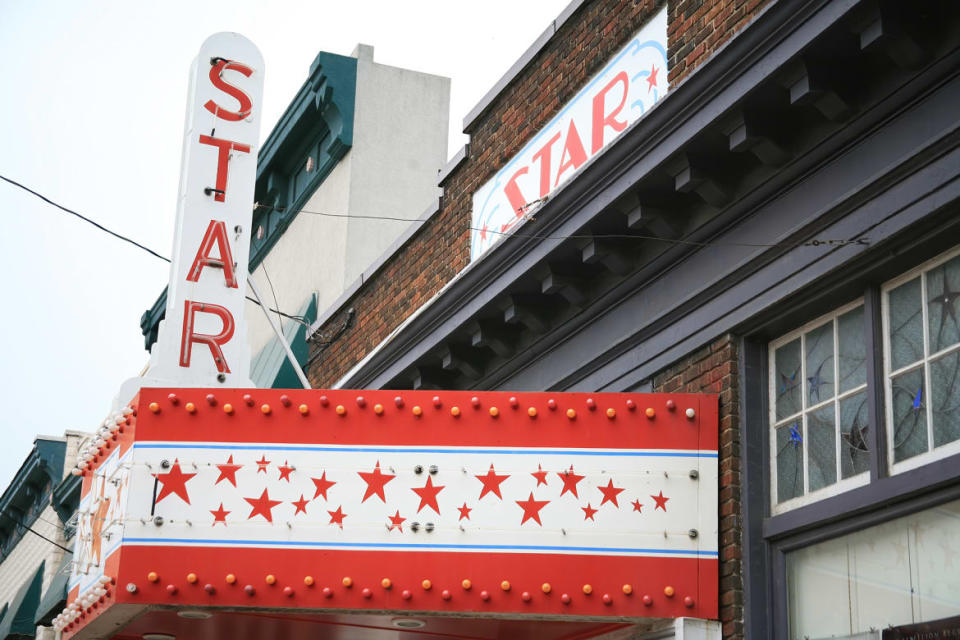
Historic Star Theatre.
West Virginia is not a terribly large or populous state. Its 1.8 million residents (roughly the same as Manhattan) are scattered across an area twice the size of neighboring Maryland. The overwhelming majority of the land is mountainous. It is the only state which lies completely within the Appalachian Mountain chain, and that topographical complexity shapes its identity. West Virginia’s strange shape (a sort of diagonal blob with a square at one end and two skinny panhandles) is largely a result of that mountainous terrain along with centuries of political division: most of its borders are defined by ridges and rivers, set first by the breakup of Virginia to form the Northwest Territory, the forerunner to Midwestern states such as Ohio and Illinois. West Virginia became an independent entity in 1863 when a group of anti-secessionist counties voted to break from neighboring Virginia during the American Civil War.
Berkeley Springs lies in the state’s eastern panhandle, a string of counties tacked onto the main body of the war-forged state in a bid to keep the Baltimore & Ohio Railroad (B&O) safely within Union territory. The area’s history stretches much farther back. Its mineral-rich springs attracted local Native peoples for ages before European settlers arrived in the 18th century. George Washington, then just 16 years old, visited the springs in 1748 on a surveying mission for Lord Fairfax, the owner of much of the surrounding area at that time. He returned often over the rest of his life, notably sending his elder brother, Lawrence, there to “take the waters” in an ultimately unsuccessful bid to cure him of tuberculosis.
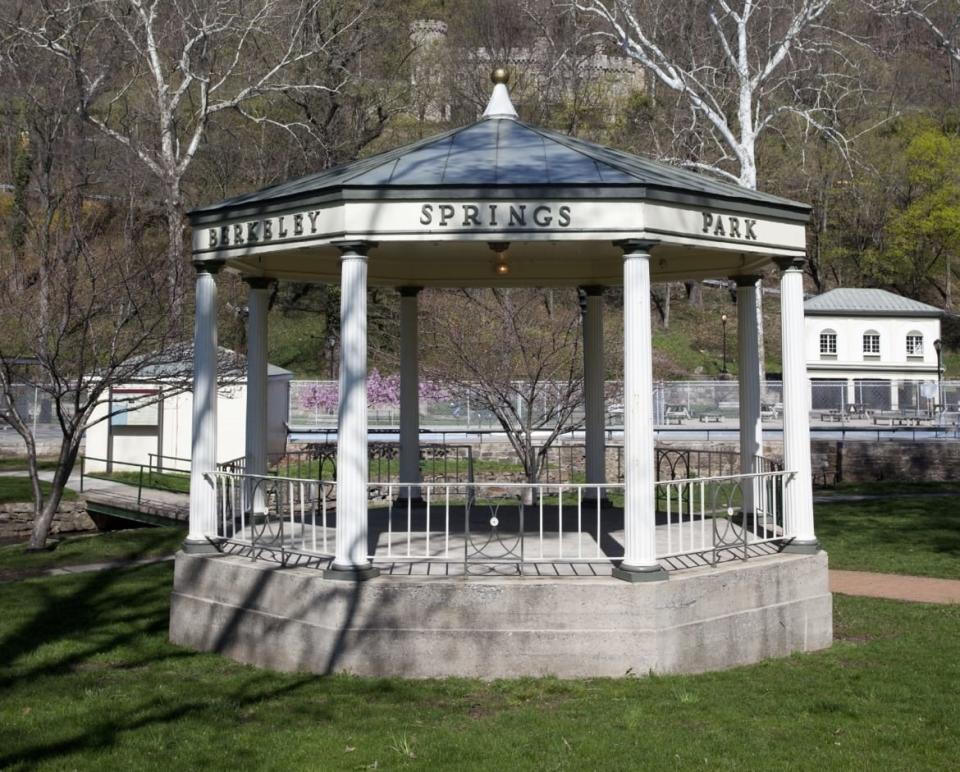
Berkeley Springs Park in Berkeley Springs, West Virginia.
I woke to a brilliant sunny sky on my second day and after a stop at local standout Fairfax Coffee House, I ventured out into nature. Just fifteen minutes south of town lies Cacapon Resort State Park, a sprawl of some 6,115 protected acres which also boasts a just-renovated lodge as well a laundry list of outdoor activities. I am an avid hiker and have long found the Appalachian Mountains to be among the most reliably beautiful landscapes in the world. My route that morning was a 5-mile loop up to the crest of Cacapon Mountain. What seemed at first to be a routine adventure became one of the most unexpectedly brilliant hikes of my life. Once I surpassed 2,000 feet elevation, the temperature dropped just to freezing, meaning the trees were gloriously encased in ice from the previous night’s storm. It was a wonderland of iridescence, and when the wind blew, flecks of ice rained down all around, causing the very air to shimmer.
Afterward, as the sun set, I treated myself to a generously-portioned meal at the Canary Grill, a new-construction restaurant perched atop a ridge overlooking downtown, before settling into the AirBnB which would be my home for the duration of my visit. The place was huge, big enough to sleep nine, though I stayed there alone. I lit a fire in the living room’s retro cone-shaped wood stove, achieving optimal hygge just as the last glow of twilight vanished behind the treetops outside the double-height windows which, in warmer seasons, would overlook a wall of new-growth greenery. It was easy to imagine how lovely a visit to this area must be during the long, lazy days of summer.
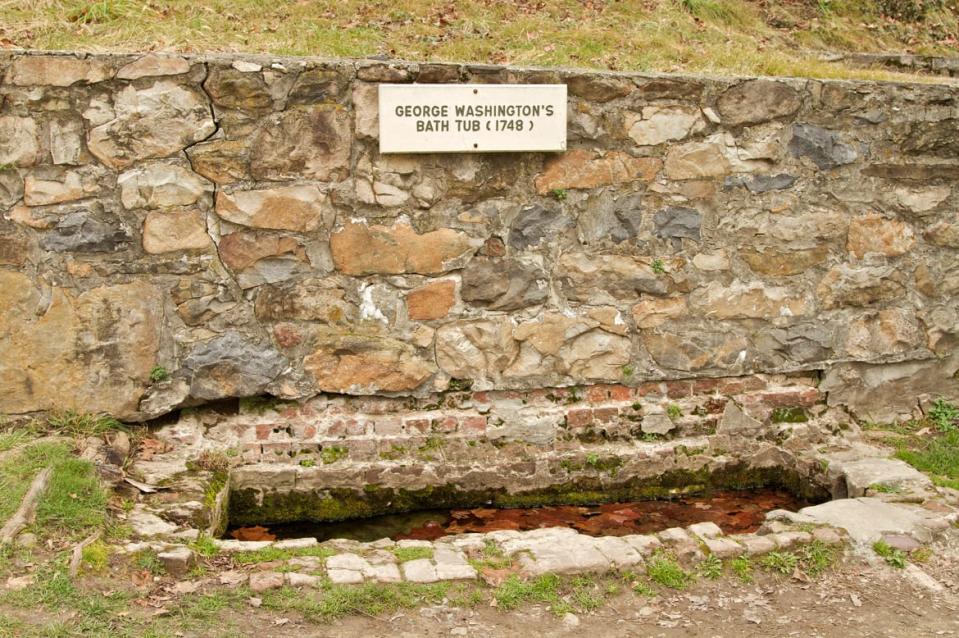
George Washington's bath tub in Berkeley Springs, West Virginia.
It snowed that night, the forest floor a blanket of white by morning. I drove into town again, this time to take a tour of Berkeley Springs’ greatest landmark: the springs themselves, which sit in the very heart of downtown, still flowing daily at a rate of 1,000 gallons per minute, just as they have for centuries. Escorting me around the property was Scott Fortney, Superintendent for the town’s state parks (Cacapon Resort, where I hiked the previous day, and the springs themselves are “sister parks” under the state’s jurisdiction), along with Jamie Foltz, manager for the spa which operates at the springs. It’s a fascinating operation, having a true spa, complete with pools, baths, fountains, and even services including massages and facials, all located within an ostensibly public space.
We spent an hour walking the grounds, admiring the many-layered history of the complex: the waterworks controlling flow and distribution are imposing and modern, but the nearby “Old Roman Bathhouse,” where guests can soak in heated spring water for $27 per half-hour, was built in 1815. After my tour, I availed myself of such a rejuvenating soak. Mineral water like that which flows at Berkeley Springs has long been credited with healing powers; after thirty minutes of floating, my skin felt softer, my head felt clearer, and my joints felt looser than they had in days. From my room’s window, I watched as a steady stream of what appeared to be locals pulled up to the park with empty gallon jugs, which they filled with spring water at a nearby spigot for use at home.
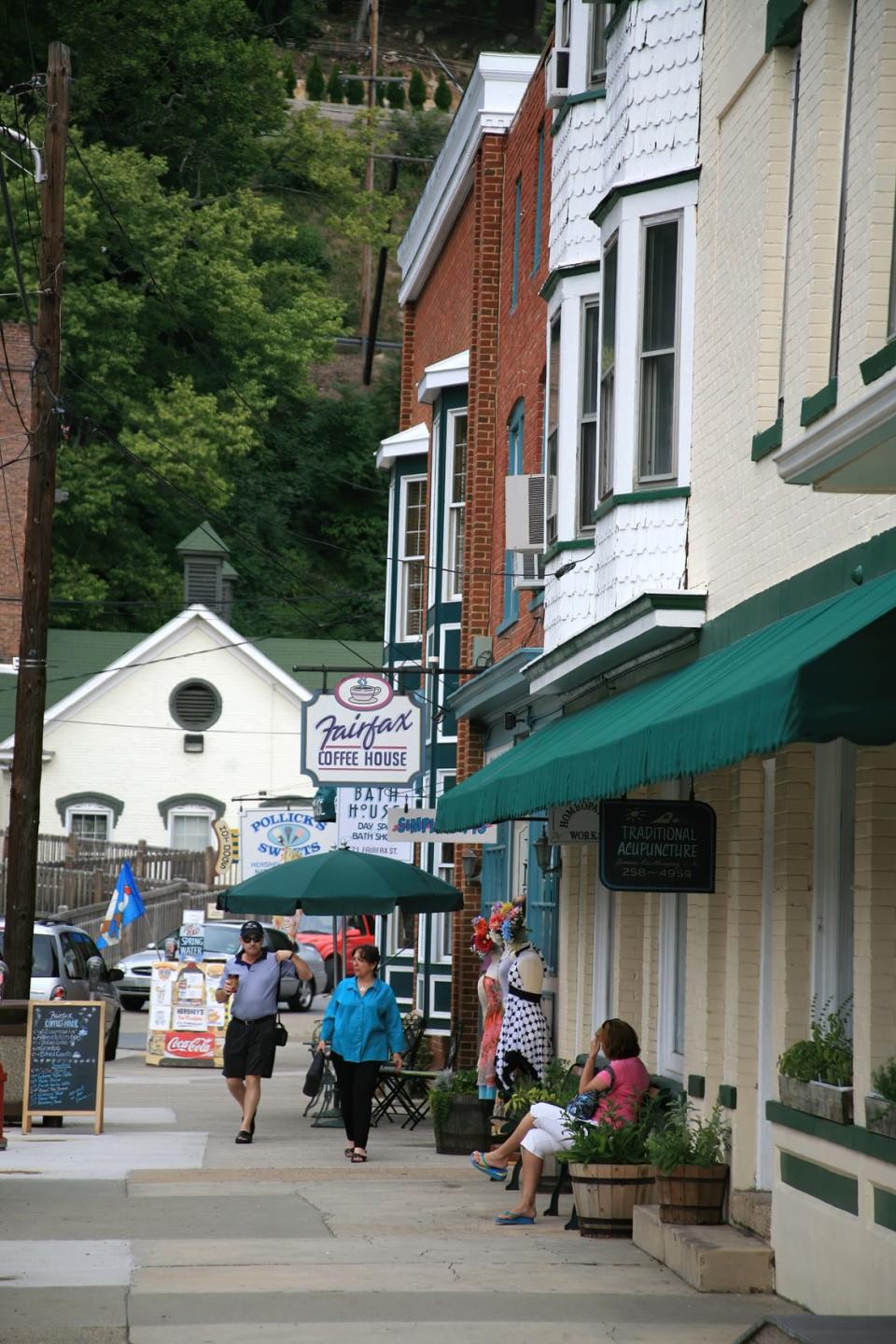
People walking around the shops and restaurants on Main Street in historic Berkeley Springs, West Virginia.
After the bath and a hearty lunch at local favorite Charlotte’s Cafe, I spent time browsing downtown Berkeley Springs’ many small shops. On one block across from the springs can be found the Berkeley Springs Antique Mall, Fleur de Lis Cheese Shop, Marley Max Candles, and other gift shops such as Mountain Laurel and Jules, selling almost exclusively locally-made arts and crafts.
In 2022, Berkeley Springs was named one of the “Best Small Towns in the U.S. for Art Lovers” by Travel+Leisure Magazine. (The list of 9 towns also features such artsy mainstays as Marfa, TX, North Adams, MA, and Cody, WY.) With a permanent population of fewer than 800 people, Berkeley Springs boasts a reported 125 full-time artists living in the immediate area, adding a note of whimsy and flair to its spa-town simplicity. Residents take obvious pride in the area’s quirky, inclusive atmosphere. Rainbow flags flutter from shopfront flagpoles, and local bumper stickers betray a left-leaning sensibility in an otherwise very-red corner of a very-red state (Morgan County voted for Donald Trump in 2020 by a 3-to-1 margin). One bartender described it to me as “the Austin of West Virginia.”
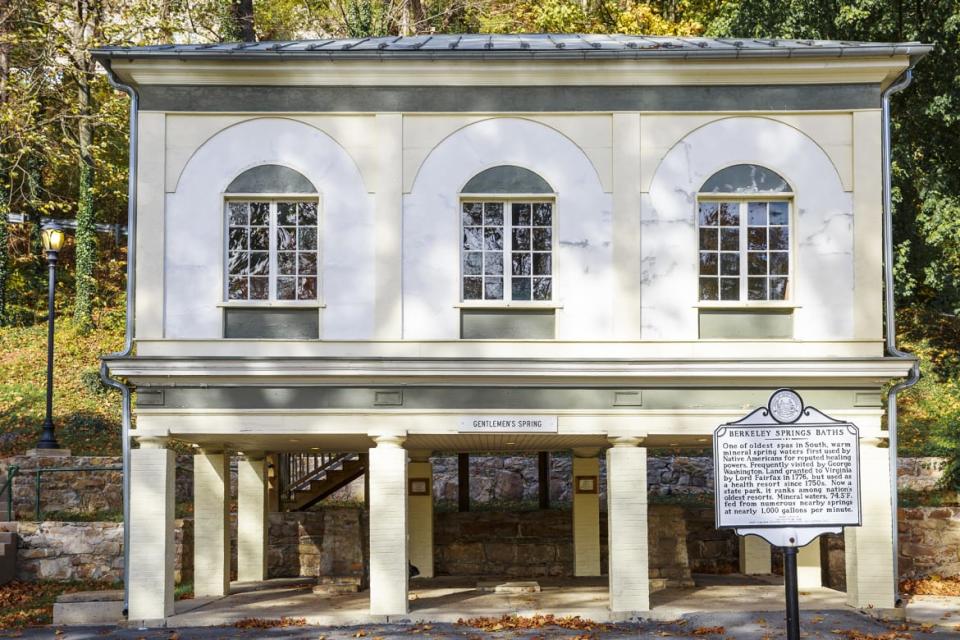
A gentleman's bath house in Berkeley Springs, West Virginia.
A short walk from the bathhouses, I visited the Ice House Artist Co-Op, a well-appointed multi-story gallery space which features only artists who live within a 50-mile radius of town. There, I was greeted warmly by ceramicist Lisa Duluth Swanson. She asked what brought me to Berkeley Springs, and when I told her I was there as a travel writer, she urged me not to write a fluff piece. We discussed the threat of gentrification faced by the area, which has seen an uptick in seasonal residents from Baltimore and Washington buying homes there, particularly in the wake of the pandemic.
More urgently, Lisa asked me if anyone had told me about “the castle,” and was visibly miffed when I told her no. The Berkeley Springs Castle is a Gilded Age folly: a weather-stained fortress of local stone, complete with turrets and grotesques, looming over the town like some minor European fiefdom. The castle was built by Samuel Suit, a wealthy businessman and politician from Maryland, for his much-younger third wife, Rosa Pelham, whom he’d met at the springs. Construction began in 1885, but Samuel died in 1888. Rosa completed the castle in 1891 but quickly burned through her vast inheritance throwing lavish parties for her circle of Washington friends. Despite selling off much of Samuel’s Maryland landholdings (an area now known as “Suitland”), Rosa lost the castle at public auction in 1913. Over the next century, it served variously as a boys’ camp, museum, and wedding venue.
In 2020, the castle was quietly sold in an all-cash deal to VDare, a group which calls itself a “civic nationalist” organization and considers immigration to be an existential threat to the nation. Its name comes from Virginia Dare, the first English child born in North America. VDare, founded by British-born Peter Brimelow, has struggled to secure locations for group meetings; venues such as Cheyenne Mountain Resort in Colorado Springs have canceled events due to the group’s revanchist positions. Mayor John Suthers later commented: “I know I am joined by many Colorado Springs residents when I say I appreciate Cheyenne Mountain Resort’s action to cancel this conference, and its conscientious decision not to bring this group to Colorado Springs.” The hope is that the castle in Berkeley Springs will free the Connecticut-based group from such hiccups.
The castle is visible from almost every corner of Berkeley Springs, and the recent sale makes many locals uneasy. VDare insists the castle will serve merely as a meeting place, but many, including Lisa at the Ice House, worry about the future. Some residents, she told me, hold to a live-and-let-live mentality: that VDare has every right to exist in town so long as they don’t cause trouble. Others fear that it may be only a matter of time before something like the deadly 2017 “Unite the Right” rally in Charlottesville, Virginia, erupts in Berkeley Springs. In a town which prides itself as an artsy refuge, and which relies so heavily on tourist dollars, such a calamity would be devastating.
Leaving the Ice House, I felt the castle’s ominous presence more acutely, and hoped the town’s fragile artistic ecosystem could withstand whatever controversy might befall it. As a palate cleanser, I paid a visit to “Give Purrs a Chance,” a cat cafe and adoption center housed in a grand old Victorian mansion painted a cheery salmon color. The non-profit opened in 2017, housing as many as 50 cats and kittens at any given time, most of whom come from partner rescue facilities in the area. When a cat is adopted, its name and photo are posted to a wall of honor. To date, more than 1,600 cats have found permanent homes through Gives Purrs a Chance, a remarkable number by any measure.
I ended my time in West Virginia by visiting two local breweries: Cacapon Mountain and Berkeley Springs. There, I saw small-town life on full display. Employees knew locals by name, brews were named after local landmarks, and everyone involved seemed to have a vested interest in the town and its success. At Berkeley Springs Brewery, I met the brewmaster, who lives on-site (the brewery also offers several rooms on AirBnB), and another employee told me that they had just hosted a contingent of state legislators who listened to their thoughts on how laws might be changed to better serve West Virginia’s budding microbrew industry.
Amid peals of raucous laughter, as dogs lazed about on the floor of the tasting room, I felt like I’d tapped into the sort of small-town interconnectedness that I seek when exploring the nation’s less-traveled thoroughfares. Places like Berkeley Springs help preserve a sense of place and time that can too easily be lost in the daily rush foisted upon us in the twenty-first century. It’s where people can still slow down to know their neighbors, share their crafts, and take time to enjoy a mineral soak just as people have been doing for centuries.
Get the Daily Beast's biggest scoops and scandals delivered right to your inbox. Sign up now.
Stay informed and gain unlimited access to the Daily Beast's unmatched reporting. Subscribe now.

 Yahoo News
Yahoo News 
